中国传统婚礼习俗英文版汇编
- 格式:ppt
- 大小:4.59 MB
- 文档页数:9
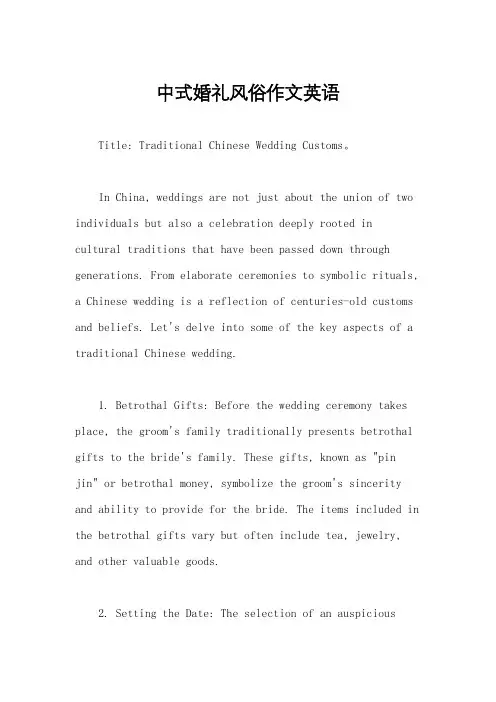
中式婚礼风俗作文英语Title: Traditional Chinese Wedding Customs。
In China, weddings are not just about the union of two individuals but also a celebration deeply rooted incultural traditions that have been passed down through generations. From elaborate ceremonies to symbolic rituals, a Chinese wedding is a reflection of centuries-old customs and beliefs. Let's delve into some of the key aspects of a traditional Chinese wedding.1. Betrothal Gifts: Before the wedding ceremony takes place, the groom's family traditionally presents betrothal gifts to the bride's family. These gifts, known as "pin jin" or betrothal money, symbolize the groom's sincerity and ability to provide for the bride. The items included in the betrothal gifts vary but often include tea, jewelry, and other valuable goods.2. Setting the Date: The selection of an auspiciouswedding date is crucial in Chinese culture. Couples consult a lunar calendar and often seek the advice of a fortuneteller to ensure that the chosen date aligns with favorable cosmic forces. Dates that are considered lucky, such as those with the number eight, are highly preferred.3. The Wedding Day: On the wedding day, the bride typically begins her day by undergoing traditional bridal preparations, which may include hair styling and makeup application. Red is the predominant color worn by the bride, symbolizing joy, luck, and prosperity. The groom also dresses in red to complement the bride.4. The Tea Ceremony: One of the most significantrituals in a Chinese wedding is the tea ceremony, known as "cha xi." During this ceremony, the newlyweds serve tea to their parents and elders as a gesture of respect and gratitude. It symbolizes the formal introduction of thebride into the groom's family and the acknowledgment oftheir new roles as husband and wife.5. Exchange of Vows and Rings: Similar to Westernweddings, Chinese couples often exchange vows and rings asa declaration of their commitment to each other. However, these exchanges may occur within the confines of atraditional ceremony, which may include rituals such as the lighting of unity candles or the sharing of "double happiness" candies.6. Banquet Reception: Following the wedding ceremony, a lavish banquet reception is held to celebrate thenewlyweds' union. Family members, friends, and other guests gather to enjoy sumptuous feasts, lively entertainment, and heartfelt speeches. Red envelopes containing money, knownas "hong bao," are often given to the couple as a token of good wishes and blessings.7. Door Games: In some regions of China, the groom and his groomsmen must undergo a series of playful challenges, known as "door games," before being granted entry to the bride's home. These games are designed to test the groom's sincerity and determination and often involve tasks that require wit, agility, and sometimes even physical endurance.8. Firecrackers and Dragon Dances: To ward off evil spirits and bring good luck to the newlyweds, firecrackers are often set off during various stages of the wedding celebration. In addition, colorful dragon dances may be performed, especially in southern China, to add to the festive atmosphere and symbolize prosperity and happiness.In conclusion, a traditional Chinese wedding is a harmonious blend of ancient customs, symbolism, and modern elements. It not only serves as a joyous occasion for the couple and their families but also as a continuation of cultural heritage and beliefs. Through rituals such as the tea ceremony, exchange of vows, and banquet reception, Chinese weddings embody the values of respect, harmony, and prosperity that have been cherished for centuries.。
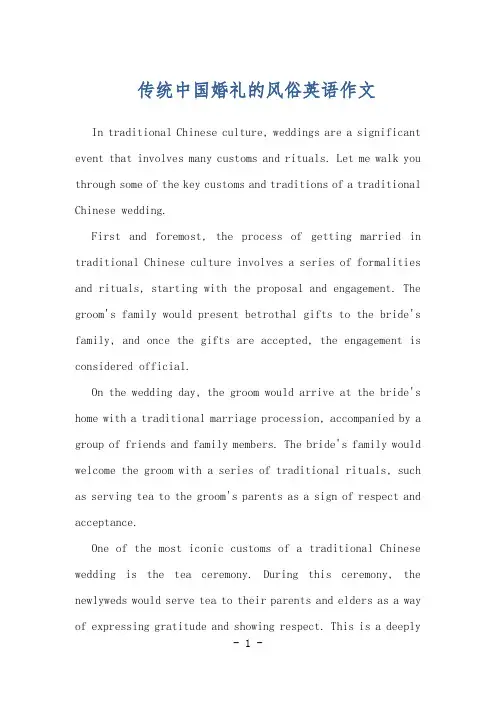
传统中国婚礼的风俗英语作文In traditional Chinese culture, weddings are a significant event that involves many customs and rituals. Let me walk you through some of the key customs and traditions of a traditional Chinese wedding.First and foremost, the process of getting married in traditional Chinese culture involves a series of formalities and rituals, starting with the proposal and engagement. The groom's family would present betrothal gifts to the bride's family, and once the gifts are accepted, the engagement is considered official.On the wedding day, the groom would arrive at the bride's home with a traditional marriage procession, accompanied by a group of friends and family members. The bride's family would welcome the groom with a series of traditional rituals, such as serving tea to the groom's parents as a sign of respect and acceptance.One of the most iconic customs of a traditional Chinese wedding is the tea ceremony. During this ceremony, the newlyweds would serve tea to their parents and elders as a way of expressing gratitude and showing respect. This is a deeplysymbolic and important tradition that signifies the union of two families.Another important aspect of a traditional Chinese wedding is the exchange of vows and rings. The bride and groom would make their vows in front of their families and friends, and exchange rings as a symbol of their commitment to each other.In terms of attire, the bride would typically wear a traditional red qipao or cheongsam, which symbolizes joy and good luck in Chinese culture. The groom would wear a traditional black silk coat with a mandarin collar, paired with black trousers.The wedding banquet is also a crucial part of a traditional Chinese wedding. It is a grand affair that involves a lavish feast with multiple courses, and is a way for the newlyweds to express their gratitude to their guests. During the banquet, there are often performances, toasts, and well-wishes from the guests.After the wedding, the bride would traditionally move into the groom's home and become a part of his family. This transition is marked by a series of rituals and customs that symbolize the bride's acceptance into her new family.Overall, a traditional Chinese wedding is a rich andmeaningful event that is steeped in centuries of customs and traditions. It is a celebration of love, family, and the joining of two lives, and is a reflection of the deep cultural heritage of the Chinese people.传统中国婚礼是一个意义重大的事件,涉及许多风俗和仪式。
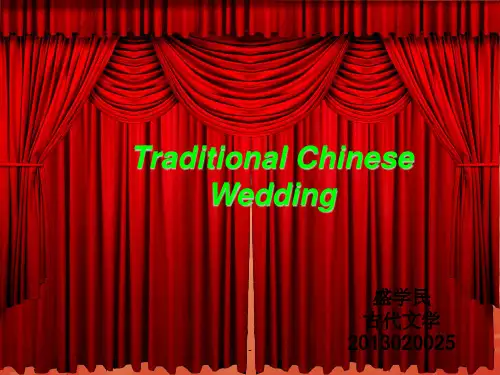
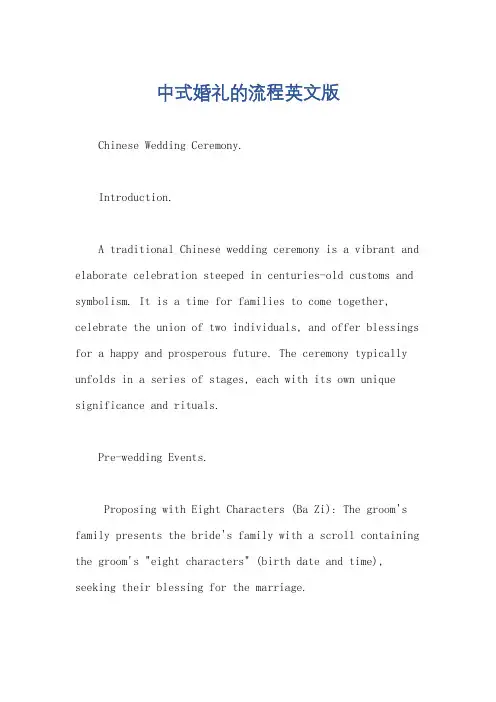
中式婚礼的流程英文版Chinese Wedding Ceremony.Introduction.A traditional Chinese wedding ceremony is a vibrant and elaborate celebration steeped in centuries-old customs and symbolism. It is a time for families to come together, celebrate the union of two individuals, and offer blessings for a happy and prosperous future. The ceremony typically unfolds in a series of stages, each with its own unique significance and rituals.Pre-wedding Events.Proposing with Eight Characters (Ba Zi): The groom's family presents the bride's family with a scroll containing the groom's "eight characters" (birth date and time), seeking their blessing for the marriage.Selecting an Auspicious Date: The wedding date is chosen carefully based on Chinese astrology to ensure good luck and prosperity for the couple.Presenting Gifts (Guo Da Li): The groom's family presents an elaborate dowry to the bride's family, including jewelry, silks, and tea, symbolizing their respect and support.Wedding Day.Groom's Procession: The groom arrives at the bride's home accompanied by a procession of musicians and helpers carrying the dowry gifts.Firecrackers and Drumming: Firecrackers are set off and drums are played to announce the groom's arrival and ward off evil spirits.Tea Ceremony: The bride and groom serve tea to their parents and other elders, symbolizing respect and filial piety.Bridal Chamber Unveiling: The couple is led to the bridal chamber, where they are expected to spend theirfirst night together.Parent's Blessings: The couple receives blessings and advice from their parents, who wish them a long and happy life together.Wedding Banquet: A grand feast is held to celebrate the marriage, with guests enjoying traditional dishes and entertainment.Post-wedding Customs.Return to the Bride's Home (Shuiqin): The bride and groom return to the bride's home for a three-day stay, where they receive gifts and well-wishes from both sides of the family.First Visit to the Ancestral Temple: The couple visits the groom's ancestral temple to pay respects to hisancestors and seek their blessings.Hair Combing Ceremony: The bride's hair is combed by her mother-in-law, symbolizing her transition into her new family.Symbolism.Red: Red is considered a lucky color in Chinese culture and is used extensively in wedding decorations, clothing, and gifts. It symbolizes joy, prosperity, and good luck.Dragon and Phoenix: The dragon and phoenix are mythical creatures that represent the bride and groom, respectively. They symbolize harmony, love, and eternal happiness.Double Happiness Symbol: This symbol, often depicted in red or gold, consists of two characters that when combined mean "double happiness." It is a popular decoration for weddings and represents the couple's desirefor a long and happy life together.Tea Ceremony: Offering tea to elders symbolizesrespect and humility, and strengthens the bond between the couple and their families.Firecrackers: The loud noise of firecrackers is believed to scare away evil spirits and bring good fortune.Modern Adaptations.While many traditional customs remain, modern Chinese weddings have incorporated some Western influences, such as:White Wedding Dress: Many brides now wear white wedding dresses, symbolizing purity and virginity.Wedding Cake: A tiered wedding cake is often served as a dessert, representing the couple's sweet future together.Wedding Vows: Couples may choose to exchange personal wedding vows, expressing their love and commitment to eachother.Ultimately, a Chinese wedding ceremony is a unique and meaningful cultural event that symbolizes the love, unity, and good wishes for two individuals beginning their lives together.。
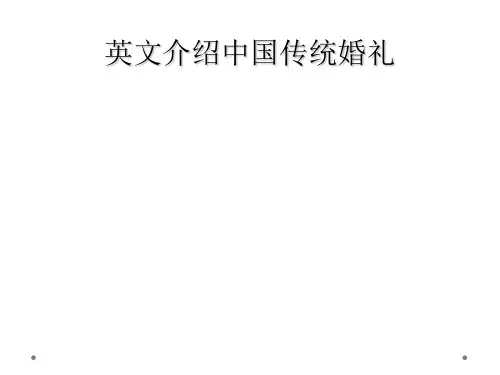
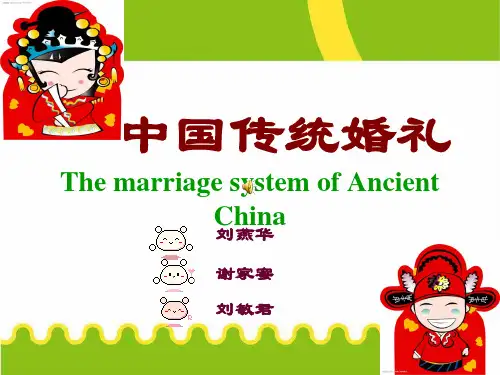
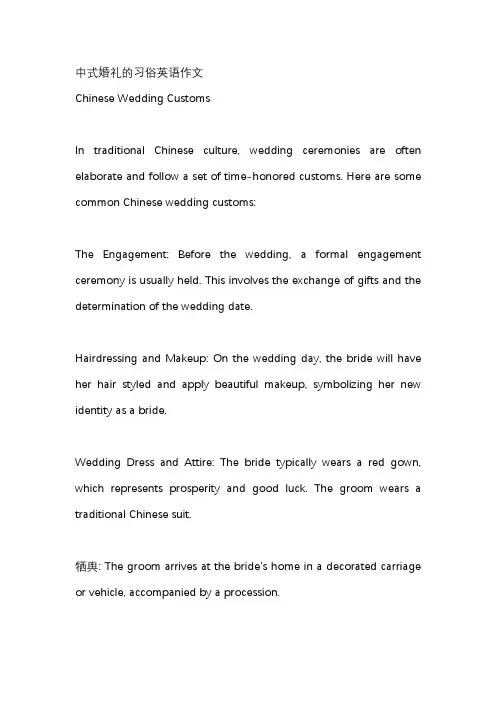
中式婚礼的习俗英语作文Chinese Wedding CustomsIn traditional Chinese culture, wedding ceremonies are often elaborate and follow a set of time-honored customs. Here are some common Chinese wedding customs:The Engagement: Before the wedding, a formal engagement ceremony is usually held. This involves the exchange of gifts and the determination of the wedding date.Hairdressing and Makeup: On the wedding day, the bride will have her hair styled and apply beautiful makeup, symbolizing her new identity as a bride.Wedding Dress and Attire: The bride typically wears a red gown, which represents prosperity and good luck. The groom wears a traditional Chinese suit.牺舆: The groom arrives at the bride's home in a decorated carriage or vehicle, accompanied by a procession.Door-Blocking and Bride's Request: The groom and his party may face some challenges or games before entering the bride's house, as a form of守门and adding to the joyous atmosphere.Tea Ceremony: After the groom enters, a tea ceremony is conducted where the bride and groom serve tea to their parents and elders as a sign of respect and gratitude.Wedding Ceremony: The actual wedding ceremony takes place, usually in a ceremony hall or a designated venue. The couple exchanges vows, rings, and performs other traditional rituals.Banquet: A grand wedding banquet is hosted to celebrate the occasion. Guests enjoy a delicious meal and exchange well wishes with the newlyweds.These are just some of the common customs in Chinese weddings, and there may be variations depending on regional and personal preferences. Each custom carries its own significance and adds to the uniqueness and charm of a Chinese wedding celebration.。
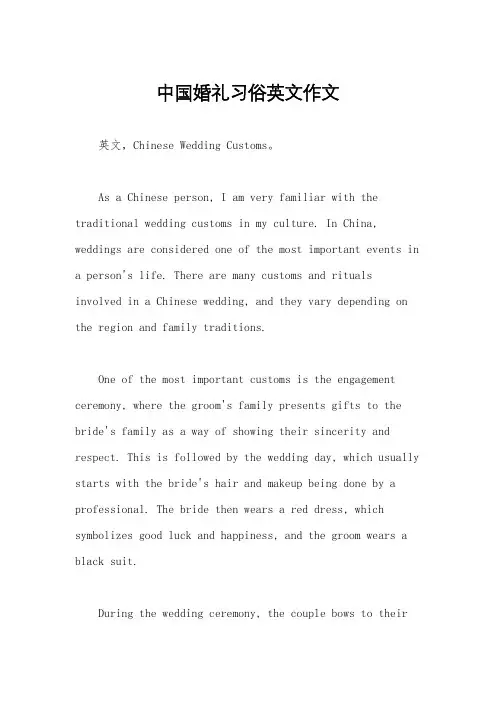
中国婚礼习俗英文作文英文,Chinese Wedding Customs。
As a Chinese person, I am very familiar with the traditional wedding customs in my culture. In China, weddings are considered one of the most important events in a person's life. There are many customs and rituals involved in a Chinese wedding, and they vary depending on the region and family traditions.One of the most important customs is the engagement ceremony, where the groom's family presents gifts to the bride's family as a way of showing their sincerity and respect. This is followed by the wedding day, which usually starts with the bride's hair and makeup being done by a professional. The bride then wears a red dress, which symbolizes good luck and happiness, and the groom wears a black suit.During the wedding ceremony, the couple bows to theirparents and then to each other as a sign of respect and gratitude. They also exchange rings and drink from a cup of wine together. After the ceremony, the couple goes to the groom's house to start their new life together.Another important custom is the wedding banquet, where the couple invites their family and friends to celebrate their marriage. The banquet usually includes many courses of delicious food and lots of toasting and speeches.中文,中国婚礼习俗。
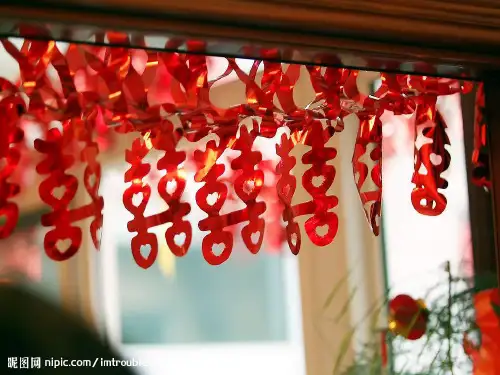
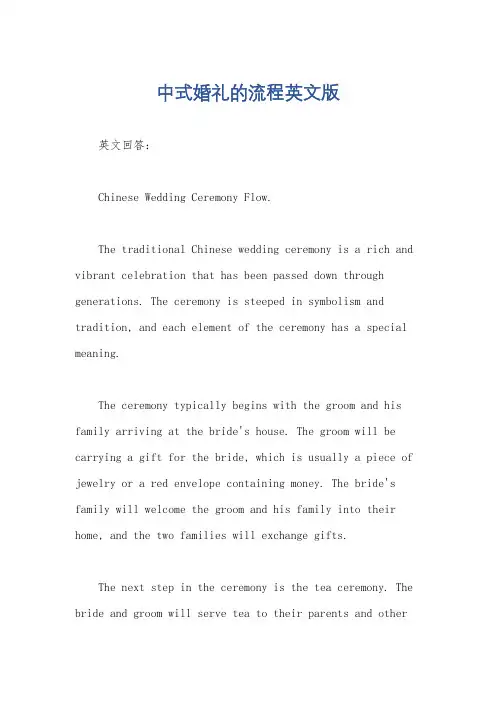
中式婚礼的流程英文版英文回答:Chinese Wedding Ceremony Flow.The traditional Chinese wedding ceremony is a rich and vibrant celebration that has been passed down through generations. The ceremony is steeped in symbolism and tradition, and each element of the ceremony has a special meaning.The ceremony typically begins with the groom and his family arriving at the bride's house. The groom will be carrying a gift for the bride, which is usually a piece of jewelry or a red envelope containing money. The bride's family will welcome the groom and his family into their home, and the two families will exchange gifts.The next step in the ceremony is the tea ceremony. The bride and groom will serve tea to their parents and otherfamily members. This is a symbolic gesture of respect and gratitude. The bride and groom will then exchange wedding rings.After the tea ceremony, the bride and groom will be led to the altar. The ceremony will be officiated by a priestor a master of ceremonies. The bride and groom will exchange vows, and they will be pronounced husband and wife.The ceremony will conclude with the bride and groom being led to the bridal chamber. The bridal chamber is a room where the bride and groom will spend their first night together as husband and wife.中文回答:中式婚礼流程。
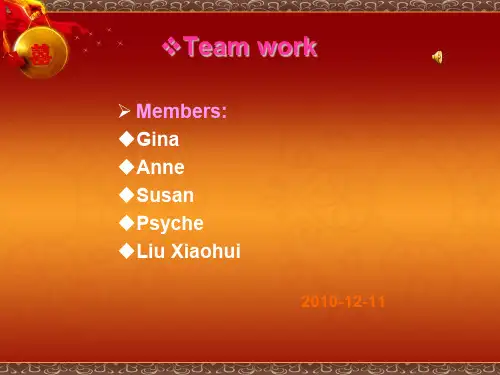
中国婚礼的风俗英文作文Title: Traditional Chinese Wedding Customs: A Colorful Cultural Tapestry。
1. Burst of Red and Gold: 。
In the heart of China's vibrant tapestry lies a wedding ceremony, a symphony of vibrant hues and rich traditions. The moment the groom steps into the bride's home, it's not just a union, but a spectacle of red and gold, symbolizing prosperity and good fortune.2. The First Look: 。
The ceremony begins with a 'gaze exchange', a custom where the couple, dressed in their finest, silently lock eyes, a test of love and commitment. It's a moment ofsilent understanding, bypassing the need for words.3. The Red Thread: 。
The red sash, or 'honghao', ties the couple together, a metaphor for the unbreakable bond. It's a physical manifestation of the ancient belief in a cosmic connection, passed down through generations.4. The Bridal Dress: 。